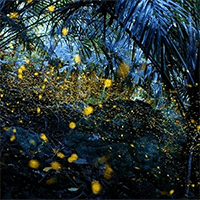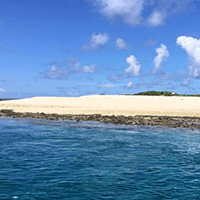- Age 0~Age 100
- 1~2 hours
- 10:00 / 11:00 / 13:00 / 14:00 / 15:00
The ruins of Shichi Castle are said to have once been the castle of Toyotomi Hideyoshi's military strategist Kuroda Kanbei and Kato Yoshiaki, one of the Seven Spears of Shizugatake. The representative of the "Society for Preserving Shichi Castle," which is dedicated to preserving the castle every day, will guide you through this precious historic site, which was an important base for the Awaji Navy under Hideyoshi. Located in Shichi, Minami Awaji City, near the Seto Inland Sea and the Naruto Strait, Shichi Castle is said to have been built by Suga Izuminokami Michitada during the Kamakura period, and was surrendered in 1581 when Toyotomi Hideyoshi attacked Awaji. After that, it was guarded by his vassal Kuroda Kanbei (Kuroda Yoshitaka), and from 1585, Kato Yoshiaki, one of the Seven Spears of Shizugatake, became the lord of the castle. The Awaji Navy, which had Shichi Castle as one of its bases, achieved great success in Hideyoshi's conquests of Kyushu, Odawara, and Korea, and there is no doubt that Awaji Island and Shichi Castle were important naval bases for Hideyoshi. However, the valuable historical site where Kuroda Kanbei and Kato Yoshiaki once lived has been swallowed up by bamboo forests in recent years and is on the verge of being forgotten by local residents. At that time, the local volunteers "Shichi Castle Preservation Society" stood up, worried that the valuable remains would disappear if things continued like this. In order to let many people, not just the locals, know about the Shichi Castle ruins and to pass on the story to future generations, they have been clearing the bamboo forest every day for about five years, and have been carrying out maintenance activities such as installing entrance roads and signs. This is a tour of the Shichi Castle ruins guided by Mr. Sekiguchi, the representative of the "Shichi Castle Preservation Society" who has a stronger passion for Shichi Castle than anyone else! The Shichi Castle ruins are currently being maintained, and recently wells and stones that are thought to be old stupas from that time have been discovered one after another. Perhaps you, as a participant of the tour, will discover an important relic! ■Experience schedule (if departing at 10:00) 10:00 Meet at the parking lot (north side of Shichi Castle ruins, across the street from the main entrance of Super Marunaka *see photo below) 10:00-10:05 Use the handmade sign as a landmark to move to the remains of the Honmarudai 10:05-10:15 Guide explains the history and characteristics of Shichi Castle 10:15-10:55 After viewing the remains such as the Taiko stone, the remains of the turret, and the old well, walk around the moat to Ise Shrine and Shomyo-ji Temple 10:55-11:00 Return to the parking lot and disband
- Age 0~Age 100
- 1~2 hours
- 09:00 / 10:00 / 11:00 / 13:00 / 14:00 / 15:00 / 16:00
Awaji tiles have been around for 400 years since the Edo period. As one of the three major tile production areas in Japan, tiles are still being manufactured there. The craftsmen who make onigawara and decorative tiles by hand are called "onishi", and it is a valuable experience to be able to see the craftsmanship of the onishi, who know the soil. Awaji tiles have been around for 400 years since the Edo period. As one of the three major tile production areas in Japan, tiles are still being manufactured there. The craftsmen who make onigawara and decorative tiles by hand, which are indispensable for temples and shrines, are called "onishi", and their numbers are decreasing, with only about 10 on the entire island of Awaji (about 50 nationwide). Tatsumi Co., Ltd., which you will visit on this plan, has five onigawara. The factory tour is a private plan limited to one group per time. With the guidance of the potter's president, Okitsu Yusuke, you will observe the tile manufacturing process and the techniques used by the onigawara craftsmen to make the onigawara tiles. You will also be able to talk to the onigawara craftsmen, who will be happy to answer any questions you may have. Afterwards, in the exhibition area, valuable pieces made during the Azuchi-Momoyama period are on display, giving you a glimpse into the evolution of this traditional craft that has continued for 400 years. Another attraction is that all the onigawara craftsmen's works from the Azuchi-Momoyama period to the present day are on display in one place. After the experience, you will be given a souvenir aromatic tile to choose from and can take home with you. Below is the experience schedule. You will be guided through the tour as follows: 1. Manufacturing site 2. Onigawara craftsmen at work 3. Onigawara collection (exhibition area)
- Age 12~Age 65
- 5~6 hours
- 10:00
In the oldest books in Japan, the Kojiki and the Nihon Shoki, it is written that the two ancestral gods Izanagi and Izanami created the land of Japan from Awaji Island, so it is called the "Island of Creation". In this retreat (tour), we will visit the sacred rocks and megaliths that are the objects of worship for the two gods. We will walk along the Izanagi Rock and mountain paths to visit megaliths such as Izanami Rock, which are not listed on tourist maps. It is a low mountain, so beginners to mountain walking are also OK. When you go through the narrow rock chamber of Izanami Rock, you will feel like you are being born through the birth canal. You can also look at the spectacular view and lie down on the megaliths, and feel the romance of the creation myths and ancient times while listening to the guide's deep and deep mythological mystery solving stories like Bura Tamori. In the mysterious nature of the Island of Creation, away from everyday life, focus on yourself and relax, refresh, and reborn your mind and body! Recommended for those who: are tired of Awaji Island's tourist attractions; want to see the unknown world of Awaji Island; want to enjoy hidden places and spectacular views of waterfalls, mountains, rural areas, the sea...; are interested in myths, power spots, and ley lines; want to get away from everyday life and relax and refresh themselves.Experience Schedule (The places and order of visits may change after consultation depending on the course and schedule, weather conditions, participants' requests, physical strength, etc.)10:00 Meeting and opening greetings10:15 Departure by car (travel in your own car with the nature guide leading the way)10:30 Walking around Izanagi Rock11:15 Car travel (travel in your own car with the nature guide leading the way)11:35 Walking around Iwakura/megalith12:00 Lunch (Hacchoiwa), Izanami Rock, Amanoiwafune, etc.14:50 Closing greetings (on site or at the meeting place)15:00 End
- Age 12~Age 100
- 1~2 hours
- 10:00 / 13:00
Surrounded by nature at the foot of a small hill, Shunyoso shows off the graceful expressions of the four seasons that are unique to Japanese-style architecture. The owner, who is also a certified old house appraiser, will guide you through the house and explain the traditional techniques that are difficult to reproduce today, the design that highlights the playfulness of the craftsmen, and the immeasurable historical and cultural value. After the tour, Shunyoso will quickly transform into a sweets shop. Enjoy an elegant moment with tea and Japanese sweets in an elegant space. Shunyoso is a masterpiece of modern Japanese architecture that was designed in 1941 by architect Toyoen Yamamoto, an authority on the study of home orientation, based on the ideas of feng shui, and was completed over a period of seven years by local carpenter Sankichi Saito and others. Further on, in 1983, the walls, gateposts, doors and gardens were renovated by architect Izue Hiroshi, who was even called a "master" by the famous architect Kurokawa Kisho, and they now harmonize beautifully to create a magnificent architectural landscape. The vast grounds of 1320m2 (approximately 1,400m2) contain eight buildings, including the guest house, storehouse, reception hall, sleeping hall and permanent residence, and in 2004 it was designated as a nationally registered tangible cultural property, and in 2017 it was designated as an important structure for the formation of the Hyogo Prefectural Landscape. However, with the aging of the population and a social trend in recent years that only pursues efficiency, it became difficult for the previous owner to maintain and manage the buildings, and they gradually deteriorated, leading to a long period of time when the gates were closed. The turning point came in 2015. In order to preserve this precious cultural asset for future generations, the fourth-generation owner purchased it and began repairs and renovations. Finally, in October 2016, Shunyo-so was revived and reborn as a new international tourist resource for Awaji Island. In this experience program, the owner himself will guide you through the house, explaining the charms of the house, such as the traditional techniques that are difficult to reproduce today, the building materials that are also difficult to obtain today, the designs that highlight the playfulness of the craftsmen scattered throughout, and the elegant furnishings, based on the historical background of Shunyo-so. Please enjoy this space, which is filled with history and culture and represents the best of traditional techniques, to the fullest. After the tour, you will be served tea and Japanese sweets in the tea room or one of your choice. Please enjoy not only as a precious cultural asset, but also as a sweet shop. *Guides in English are also available, so we can accommodate customers from overseas. *A five-minute walk from Shunyoso is the historic and prestigious "Takenoguchi Hachiman Shrine," which celebrated its 1,100th anniversary in 2021. Why not visit the shrine as well? You can also enjoy a stroll through the historical and atmospheric streets of the Takenoguchi area. Experience schedule (The schedule below starts at 10:00, but please read the time differently if starting at 13:00) 10:00 Meet on site 10:05 Check-in and briefing Guided tour of Shunyoso 11:00 Enjoy tea and Japanese sweets in the teahouse. 11:30 End
- Age 6~Age 100
- 2~3 hours
- 10:00 / 13:00 / 15:00
At Senkoji Temple, which boasts a history of 1100 years and has a temple on the summit of Sakiyama, a sacred mountain on Awaji Island, you can visit the main hall while enjoying the view of Sumoto City, one of the eight scenic views of Sumoto, and experience a sutra copying experience in a mysterious silence, which is an extraordinary experience. If you wish, you can also visit Iwato Shrine after the experience. Sakiyama, also known as Awaji Fuji, is said to be the first mountain created in Japan in the legend of the creation of the world by the gods Izanagi and Izanami. At Senkoji Temple, which has a temple on the summit of Sakiyama, you can experience copying sutras. First, you can climb about 200 steps to tour the grounds of Senkoji Temple, learn about the origins of Senkoji Temple, and see the place where the Awaji Island custom of "Dango Korogashi", which is rare nationwide, is performed at the temple. You will also be greeted by a lion-like boar, instead of a lion-dog, enshrined in front of the main hall. Because it is a temple on the mountaintop, you can see the central and southern part of Awaji Island, and if the weather is good, you can see the Naruto Strait and Wakayama. Return to the temple office and go to the "Daishido" to experience copying sutras. In copying sutras, you will copy the general Heart Sutra. Place the paper on top of the model Heart Sutra and copy it with a brush pen. Beginners are also welcome. By copying the characters in a solemn space, you can spend a valuable time reflecting on yourself. You can donate the copy to the temple or take it home. After the experience, you can also visit "Iwato Shrine", a popular power spot that enshrines a huge rock where Amaterasu Omikami hid herself, about 10 minutes down from the temple. (Please note that this is a full-scale mountain path) Experience schedule (for example, if the tour starts at 13:00) Meet at 13:00 *Walk around the temple grounds, including visiting the main hall (guided by the head priest Okazaki) 14:00 Experience copying sutras at the Daishido (approx. 30 minutes to 1 hour) 15:00 Scheduled end *After the tour, you can walk around the temple grounds and visit Iwato Shrine (on your own). It takes about 10 minutes to walk one way up the mountain path to Iwato Shrine.
- Age 12~Age 100
- 2~3 hours
- 10:00 / 14:00
Naohara Gyokusei is a master of Nanga painting who grew up on Awaji Island. He is also a Rinzai Obaku sect monk, and at Kokusei Zenji Temple, which he rebuilt, you can enjoy a beginner-friendly zazen experience and appreciate Gyokusei's friendly Nanga paintings that he personally painted. After the 60-minute zazen experience, you will listen to the current chief priest explain the Zen teachings contained in Gyokusei's works while drinking tea, then move to Minami Awaji City Takikawa Memorial Museum Gyokuseikan (5-minute walk) and view the diverse works of Naohara Gyokusei that are housed in the museum. This is a special experience that expresses the trinity of Nanga, haiku, and Zen, and allows you to feel the spirit of "kugazenichinyo" and reflect on yourself. Naohara Gyokusei is a master of Nanga painting who has ties to Awaji Island. He was also a painter and haiku poet, and a Rinzai Obaku sect monk, and became the chief priest to rebuild the dilapidated Zen temple Kokusei-an (later Kokusei Zenji) on Awaji Island where he grew up. At Kokusei Zenji Temple, which was magnificently rebuilt by Gyokusei, you will first complete a beginner-friendly zazen experience (about 60 minutes), after which you will listen to the current head priest explain the Zen teachings contained in Gyokusei's works while drinking tea, and then view Gyokusei's intimate works, which are privately painted by Gyokusei and housed in a storehouse within the temple grounds. You will be able to view rare sliding door paintings and other works up close without any partitions. After that, you will move to the Takikawa Memorial Museum of Art Gyokuseikan (about a 5-minute walk, 200m), where many of Gyokusei's paintings are on display, and finally view the masterpieces housed in the museum's collection. You will be able to experience a special time to reexamine yourself through the spirit of "Kuga Zen Ichinyo," which expresses the trinity of Nanga, haiku, and Zen that Naohara Gyokusei loved.
- Age 6~Age 100
- 2~3 hours
- 09:00 / 10:00 / 11:00 / 13:00 / 14:00
Daisuke Michigami, a roofer who has inherited the family business (president of Daiei Ceramics), continues to take on the "indefatigable challenge" of unraveling the "wisdom," "skills," and "teachings" of his predecessors that are embedded in each and every "Awaji tile," a traditional industry that has a history of 400 years, and passing them on to the future. What is the reason for continuing to take on new challenges? We will get to the bottom of the secret. Daisuke Michigami, a roofer, will talk about the charm of "tiles" created by the soil of Awaji over time, the thoughts he puts into making each and every tile, the scenery created by the layers of "tiles," and his commitment to the "beauty" of Japanese architecture, all at "Gallery Doza," a space completely wrapped in soil and tiles. Awaji tiles were hit hard by the unfounded rumor that "the damage caused by the Great Hanshin-Awaji Earthquake was so great because the roofs were tiled." Even in an environment where the survival of Awaji tiles is still in doubt, Michigami has found great potential in "Ginfurubi" (tiles that are new yet somehow nostalgic, baked to a vintage, antique texture), and has been bringing out new charms of Awaji tiles that are different from anything that has come before. Now that his thoughts have taken shape, tiles are connecting people with each other, and Japan's good old traditional beauty is being reevaluated. Tile maker Michigami Daisuke's "insatiable challenge" will continue. After listening to his story, you can enjoy a space surrounded by earth and tiles that you would never believe is inside a tile factory, a view of the townscape that has flourished due to tile production since the Edo period, and Michigami's passion for "beauty" at "Gallery Doza," where you can feel Michigami's passion for "beauty." You can pretend to be a tile craftsman and try making your own "one-of-a-kind tile coaster," one of the new possibilities of tiles. You can choose from a variety of Japanese pattern designs that are prepared in advance, as well as original designs. Try making a rich work full of your sensibility. Experience schedule9:00~ (20 minutes) Message from tile maker Daisuke Michigami (President of Daiei Ceramics Co., Ltd.) - "Creating the future of tiles" - He will talk while showing slides at [Gallery Doza].9:20~11:20 Experience making your own original tile coaster that is one of a kind in the world *You can start at any time between 9:00 and 14:00.
- Age 12~Age 90
- Over 6 hours on the day
- 09:00
He has also appeared in various media! This is a full-scale one-day training in traditional Japanese martial arts by Isao Machii, the world's best iaido master, who is also known for turning 6mm BB bullets flying at high speed into iaido. You can learn all kinds of traditional Japanese martial arts, such as the structure of a sword and its correct usage, extensive knowledge about samurai and Japanese swords, swordsmanship and martial arts. Genuine traditional Japanese martial arts, not just formal martial arts, apply the opponent's strength and toy with the opponent with small movements. By learning it, you can apply it in your private life, so your worldview will change drastically. Take this opportunity to experience the authentic samurai culture by putting on training clothes and dispelling the incorrect samurai culture and sword knowledge that is prevalent all over the world. *Due to the guidance of the Agency for Cultural Affairs and the National Police Agency, this plan does not provide instruction on test cutting with Japanese swords to anyone other than disciples. ~ Flow of one day training ~ 8:40 Meet at Hankyu "Kawanishi Noseguchi Station" or JR "Kawanishi Ikeda Station" and move to Tada Shrine by free shuttle. 9:00 Arrive at Tada Shrine 9:10 After changing clothes, receive a prayer, and then the first half of the practice will start. 12:00 Lunch break (enjoy a luxurious kaiseki meal) 13:00 Second half of the practice starts 16:00 Practice ends After changing clothes, we will disband.
最近チェックしたプラン
Please wait a moment
![[Hyogo, Minami Awaji] A local guide will guide you to the ruins of Shichi Castle, an important base for the Awaji Navy! A tour of Hideyoshi's army's key locations, where Kanbei Kuroda and Yoshiaki Kato, who were said to be genius military strategists, were stationedの画像](https://img.activityjapan.com/10/58645/10000005864501_1Gz5AIDf_3.webp?version=1744260783)
![[Hyogo, Minami Awaji] 400 years of history! Japan's three major tile production areas: Onigawara craftsmen on Awaji Island: Experience the craftsmanship of Onishi up close and see the manufacturing process! Awaji tile kiln tour experienceの画像](https://img.activityjapan.com/10/58514/10000005851401_1Gz5AIDf_3.webp?version=1743490147)
![[Hyogo, Awaji] An exclusive nature tour on the island of the creation myth - A retreat series where a famous guide will show you spots that even locals don't know aboutの画像](https://img.activityjapan.com/10/58497/10000005849701_1Gz5AIDf_3.webp?version=1743400627)
![[Hyogo, Sumoto] <Nationally Registered Tangible Cultural Property> The elegant Japanese-style building "Shunyoso" is imbued with the power of Feng Shui. Immerse yourself in the tasteful and precious historical and cultural space.の画像](https://img.activityjapan.com/10/58456/10000005845601_1Gz5AIDf_3.webp?version=1743128703)
![[Hyogo, Sumoto] Experience something out of the ordinary at Senkoji Temple, located on Sakiyama, which is said to be the first mountain to be created in Japan in the "creation mythology" <copying sutras experience>の画像](https://img.activityjapan.com/10/58443/10000005844301_1Gz5AIDf_3.webp?version=1743129423)
![[Hyogo, Minami Awaji] Experience Zen meditation and appreciating the Nanga paintings of Gyokusei Jikihara at a Zen temple associated with the master of Nanga painting who grew up on Awaji Island.の画像](https://img.activityjapan.com/10/58500/10000005850001_1Gz5AIDf_3.webp?version=1743403386)
![[Hyogo, Minami Awaji] Awaji tiles, a traditional industry with 400 years of history. A tile maker who continues to challenge himself to create the beauty of Japanese architecture. A coaster-making experience.の画像](https://img.activityjapan.com/10/58552/10000005855201_1Gz5AIDf_3.webp?version=1743738427)
![[Hyogo, Kawanishi City] Reserve a portion of Tada Shrine, the birthplace of the Genji clan! Learn samurai martial arts directly from the world's best iaido master, Isao Machii, for a full-fledged one-day training session!の画像](https://img.activityjapan.com/10/49462/10000004946201_atFOJjl6_3.jpg?version=1744113183)







